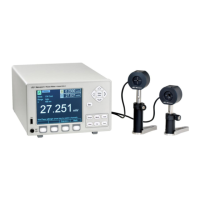124 Principles of Operation
9.10 Measurement Considerations
This section describes detector characteristics, optical and electrical
considerations, and environmental influences on optical measurements. In
general, measurement accuracy is limited by the accuracy of the detector
calibration.
Accurate measurements, however, are also dependent upon proper set-up,
control of temperature and illumination conditions and understanding the
factors that affect optical measurements.
9.10.1 Detector Calibration and Accuracy
Newport Corporation calibrates its detectors using secondary standards directly
traceable to the United States National Institute of Science and Technology
(NIST), National Research Council (NRC) of Canada, or to Great Britain’s
National Physical Laboratory (NPL).
The details and accuracy of the calibration procedure vary with each detector
model but a detailed description of the calibration results is supplied with
each individually calibrated detector. In general, detector calibration accuracy
varies from 2% to 5% in absolute terms and varies with wavelength. Each
detector will also have some variation in response over its surface. Therefore,
for the most reproducible measurements, light should illuminate the detector
as uniformly as possible over 80% of the detector’s active area.
CAUTION
Avoid focusing a light source onto the detector surface.
Inaccurate readings and possible detector damage may result.
Consult the detector manual for saturation or damage
thresholds.
NIST trace ability requires that detectors be recalibrated on one-year intervals.
As individual detector responses change with time, especially in the
ultraviolet, recalibration is necessary to assure confidence in the accuracy of
the measurement. For the most reproducible measurements, the same detector
should always be used for measurements that are to be directly compared.
9.10.2 Quantum Detector Temperature Effects
Semiconductor (Newport Low-Power) detectors are affected by temperature.
At long wavelengths, quantum detectors typically lose sensitivity with
increasing temperature. Additionally, detector dark current increases
exponentially with temperature. For silicon detectors, dark current is
generally on the order of a few picoamps at room temperature. With uncooled
germanium detectors , however, this dark current is on the order of a
nanoamp, or typically 1,000 to 10,000 times greater than silicon. Observed
dark current is often dominated by the interaction between the detector and a

